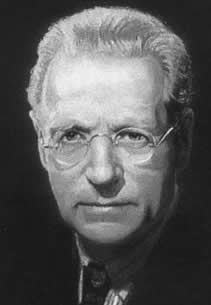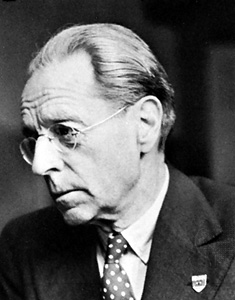<Back to Index>
- Inventor Henry George "Harry" Ferguson, 1884
- Painter Gerard van Honthorst (Gherardo delle Notti), 1592
- Mughal Emperor of India Shahanshah Aurangzeb Alamgir I, 1618
PAGE SPONSOR


Henry George "Harry" Ferguson (4 November 1884 – 25 October 1960) was an Irish engineer and inventor who is noted for his role in the development of the modern agricultural tractor, for becoming the first Irishman to build and fly his own aeroplane, and for developing the first four-wheel drive Formula One car, the Ferguson P99. Today his name lives on in the name of the Massey Ferguson company.
Ferguson was born at Growell, near Dromore, County Down and was the son of a farmer.
In 1902
Ferguson went to work with his brother Joe in his bicycle and car repair business. Whilst
working there as a mechanic, he developed an interest in aviation,
to the extent of visiting airshows abroad. In 1904, he began
to race motorcycles. In 1909
Ferguson became the first person to fly in Ireland, when he took off on
31 December in a monoplane he
had designed and built himself. After falling out with his brother over
the safety and future of aviation Ferguson decided to go it alone, and
in 1911 founded a company selling Maxwell,
Star and Vauxhall cars and Overtime
Tractors — eventually to be named Harry Ferguson
Limited. Ferguson
saw at first hand the weakness of having tractor and plough as separate
articulated units, and in 1917 he devised a plough which could be
rigidly attached to a Model T Ford car - the Eros, which became a
limited success, competing with the
Model F Fordson. Ferguson
eventually founded the Ferguson-Sherman Inc., along with Eber and
George Sherman. The new enterprise developed a ploughing system that
incorporated a Duplex hitch system which fitted the Fordson line
tractors. Ferguson's new hydraulic system was first seen on the
Ferguson - Brown Model A tractors. Ferguson eventually made a handshake
agreement with Henry Ford so that Ford could use
Ferguson's three-point
hitch system on
his new line of tractors (9N, 2N, and 8N). Henry Ford II,
Ford's grandson, abruptly ended the handshake deal on 30 June 1947.
Ferguson's reaction was a law suit demanding $251,000,000 in all. The
disagreement was settled by Ferguson in April 1952. A year later
Ferguson merged with Massey Harris to become Massey - Harris - Ferguson
Co.
This merger eventually turned into Massey Ferguson.
He also opened the Banner lane plant in Coventry. Ferguson's research
division went on to develop various cars and tractors, including the
first Formula One 4 wheel drive car. A blue plaque commemorating
Ferguson is mounted on the Ulster Bank building in Donegall Square,
Belfast, the former site of his showroom. A granite memorial has been
erected to Ferguson's pioneering flight on the North Promenade, Newcastle.
A full scale replica of the Ferguson monoplane and an early Ferguson
tractor and plough can be seen at the Ulster Folk and
Transport Museum at Cultra. Ferguson
was commemorated in 1981 when he appeared on stamps issued by the Irish
Post Office in the Republic of
Ireland. In Northern Ireland,
Ferguson's image appears today on the obverse of £20
sterling notes issued
by the Northern Bank. In
2008 the Harry Ferguson Memorial gardens were officially opened.
Situated opposite the house Harry Ferguson lived in, just outside
Dromara, Co. Down. A sculpture of Harry Ferguson was erected in the
garden and sees the famous man leaning on a fence surveying the view.
Sculpted by Whiteabbey based artist, John Sherlock. The gardens are
open to the public. The
University of Ulster opened the Harry Ferguson Engineering Village
(18th February 2004) on the Jordanstown campus in recognition of the
outstanding contribution made by Harry to Engineering and innovation in
Ireland. He
died at his home at Stow-on-the Wold in 1960, the result of an
barbiturate overdose, a coroner's ruling was unable to conclude whether
this had been accidental or deliberate.